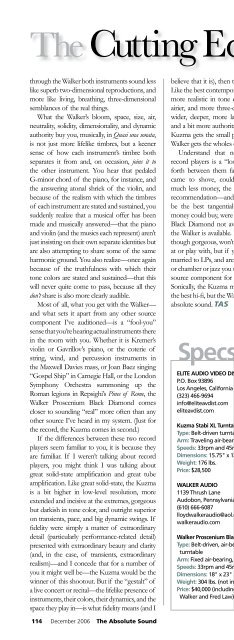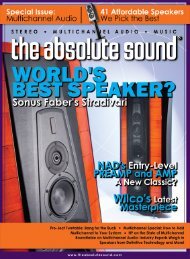You also want an ePaper? Increase the reach of your titles
YUMPU automatically turns print PDFs into web optimized ePapers that Google loves.
The Cutting Edge<br />
through the Walker both instruments sound less<br />
like superb two-dimensional reproductions, and<br />
more like living, breathing, three-dimensional<br />
semblances of the real things.<br />
What the Walker’s bloom, space, size, air,<br />
neutrality, solidity, dimensionality, and dynamic<br />
authority buy you, musically, in Quasi una sonata,<br />
is not just more lifelike timbres, but a keener<br />
sense of how each instrument’s timbre both<br />
separates it from and, on occasion, joins it to<br />
the other instrument. You hear that pedaled<br />
G-minor chord of the piano, for instance, and<br />
the answering atonal shriek of the violin, and<br />
because of the realism with which the timbres<br />
of each instrument are stated and sustained, you<br />
suddenly realize that a musical offer has been<br />
made and musically answered—that the piano<br />
and violin (and the musics each represent) aren’t<br />
just insisting on their own separate identities but<br />
are also attempting to share some of the same<br />
harmonic ground. You also realize—once again<br />
because of the truthfulness with which their<br />
tone colors are stated and sustained—that this<br />
will never quite come to pass, because all they<br />
don’t share is also more clearly audible.<br />
Most of all, what you get with the Walker—<br />
and what sets it apart from any other source<br />
component I’ve auditioned—is a “fool-you”<br />
sense that you’re hearing actual instruments there<br />
in the room with you. Whether it is Kremer’s<br />
violin or Gavrillov’s piano, or the coterie of<br />
string, wind, and percussion instruments in<br />
the Maxwell Davies mass, or Joan Baez singing<br />
“Gospel Ship” in Carnegie Hall, or the London<br />
Symphony Orchestra summoning up the<br />
Roman legions in Repsighi’s Pines of Rome, the<br />
Walker Proscenium Black Diamond comes<br />
closer to sounding “real” more often than any<br />
other source I’ve heard in my system. (Just for<br />
the record, the Kuzma comes in second.)<br />
If the differences between these two record<br />
players seem familiar to you, it is because they<br />
are familiar. If I weren’t talking about record<br />
players, you might think I was talking about<br />
great solid-state amplification and great tube<br />
amplification. Like great solid-state, the Kuzma<br />
is a bit higher in low-level resolution, more<br />
extended and incisive at the extremes, gorgeous<br />
but darkish in tone color, and outright superior<br />
on transients, pace, and big dynamic swings. If<br />
fidelity were simply a matter of extraordinary<br />
detail (particularly performance-related detail)<br />
presented with extraordinary beauty and clarity<br />
(and, in the case, of transients, extraordinary<br />
realism)—and I concede that for a number of<br />
you it might well be—the Kuzma would be the<br />
winner of this shootout. But if the “gestalt” of<br />
a live concert or recital—the lifelike presence of<br />
instruments, their colors, their dynamics, and the<br />
space they play in—is what fidelity means (and I<br />
believe that it is), then the Walker wins handily.<br />
Like the best contemporary tubes, it is fuller and<br />
more realistic in tone color; bigger, bloomier,<br />
airier, and more three-dimensional in imaging;<br />
wider, deeper, more layered in soundstaging;<br />
and a bit more authoritative dynamically. If the<br />
Kuzma gets the small parts closer to right, the<br />
Walker gets the wholes closer to right.<br />
Understand that neither of these great<br />
record players is a “loser.” I switch back and<br />
forth between them fairly often and, if push<br />
came to shove, could live with either. For<br />
much less money, the Kuzma is a no-brainer<br />
recommendation—and would undoubtedly<br />
be the best tangential-tracking record player<br />
money could buy, were the Walker Proscenium<br />
Black Diamond not available. But, of course,<br />
the Walker is available. It’ll cost you more and,<br />
though gorgeous, won’t be quite as sexy to look<br />
at or play with, but if you have the dough, are<br />
married to LPs, and are into symphonic or folk<br />
or chamber or jazz you simply can’t find a better<br />
source component for any amount of money.<br />
Sonically, the Kuzma may come a bit closer to<br />
the best hi-fi, but the Walker comes closer to the<br />
absolute sound. TAS<br />
<strong>Specs</strong> & <strong>Pricing</strong><br />
ELITE AUDIO VIDEO DISTRIBUTION (KUZMA)<br />
P.O. Box 93896<br />
Los Angeles, California 90093<br />
(323) 466-9694<br />
info@eliteavdist.com<br />
eliteavdist.com<br />
Kuzma Stabi XL Turntable/Air Line Arm<br />
Type: Belt-driven turntable<br />
Arm: Traveling air-bearing, tangential<br />
Speeds: 33rpm and 45rpm<br />
Dimensions: 15.75" x 12.6" x 12.6"<br />
Weight: 176 lbs.<br />
Price: $28,500<br />
WALKER AUDIO<br />
1139 Thrush Lane<br />
Audobon, Pennsylvania 19403<br />
(610) 666-6087<br />
lloydwalkeraudio@aol.com<br />
walkeraudio.com<br />
Walker Proscenium Black Diamond Record Player<br />
Type: Belt-driven, air-bearing, air-supported<br />
turntable<br />
Arm: Fixed air-bearing, tangential<br />
Speeds: 33rpm and 45rpm<br />
Dimensions: 18" x 23"<br />
Weight: 304 lbs. (not including air supply)<br />
Price: $40,000 (including in-home setup by Lloyd<br />
Walker and Fred Law)<br />
Footnotes<br />
1<br />
The little length of airsupply<br />
hose and the<br />
little loop of tonearm<br />
wire that feed into and out of the Kuzma’s traveling<br />
bearing may exert some progressive “lift” on the<br />
tonearm. I noted, a bit to my dismay, that on the<br />
Kuzma VTF consistently measured .15 grams less at<br />
the end of a record side than it did at the beginning.<br />
Since the Air Line (or rather the stand it sits on) was<br />
leveled perfectly by Scot Markwell of Elite Distribution<br />
(Kuzma’s importer/distributor) and double-checked<br />
by my friend Bill Parish (a Kuzma dealer), I can only<br />
guess that variations in the tension and torsion of<br />
these two sets of hoses may be contributing to the<br />
problem, which is audible, by the way, as a slight<br />
progressive “lightening” of the overall sound, rather<br />
as if VTA were gradually being raised just a tiny<br />
amount towards the end of the record. (The Walker<br />
does not suffer from this problem.)<br />
2<br />
Though expensive to make and tricky to properly<br />
implement, a really well-engineered air-bearing is<br />
perhaps the stiffest and most friction-free of all<br />
bearings, which is why it is so often used in critical<br />
high-end industrial applications.<br />
3<br />
Though Kuzma claims that the Stabi XL’s massive<br />
platter will start rotating within 30 seconds of<br />
turning on the motor controller, more often than<br />
not I found that I had to give the platter a little push<br />
to overcome its inertia and set it spinning. Once in<br />
motion, however, the platter continues to spin, even<br />
if you slow it down or stop it to change records or<br />
put on the record clamp. (The Walker Proscenium<br />
Black Diamond’s giant platter also has to be started<br />
by hand.) Neither turntable uses vacuum hold-down;<br />
both depend, instead, on a massive clamp to flatten<br />
records against the platter surface. Both also provide<br />
variable viscous damping for the tonearm, an option<br />
you can choose to use—or not.<br />
JV’s Exotica Reference System<br />
Loudspeakers: MAGICO Mini with two Wilson-<br />
Benesch Torus subwoofers, MBL 101 E,<br />
Ascendo M-S Mk II<br />
Linestage preamps: Audio Research Reference 3,<br />
MBL 6011 E<br />
Phonostage preamps: Audio Research PH-7,<br />
Lamm Industries LP-2 Deluxe<br />
Power amplifiers: Audio Research Reference 210,<br />
MBL 9008, MBL 9011, Edge 12.1<br />
Analog source: Walker Audio Proscenium Black<br />
Diamond record player, Kuzma Stabi XL<br />
turntable, Kuzma Air Line tonearm<br />
Phono cartridges: Air Tight PC-1, London<br />
Reference<br />
Digital source: MBL 1621 A transport,<br />
MBL 1611 DAC<br />
Cable and interconnect: Tara Labs “Zero”<br />
interconnect, Tara Labs “Omega” speaker cable,<br />
Tara Labs “The One” power cords<br />
Accessories: Shakti Hallographs; Walker Prologue<br />
Reference equipment stand; Walker Prologue<br />
amp stands; Richard Gray Power Company 600S/<br />
Pole Pig line/power conditioner; Cable Elevators<br />
Plus; Walker Valid Points and Resonance Control<br />
discs; Winds Arm Load meter; Clearaudio Matrix<br />
record cleaner; HiFi-Tuning silver/gold fuses<br />
114 December 2006 The Absolute Sound










